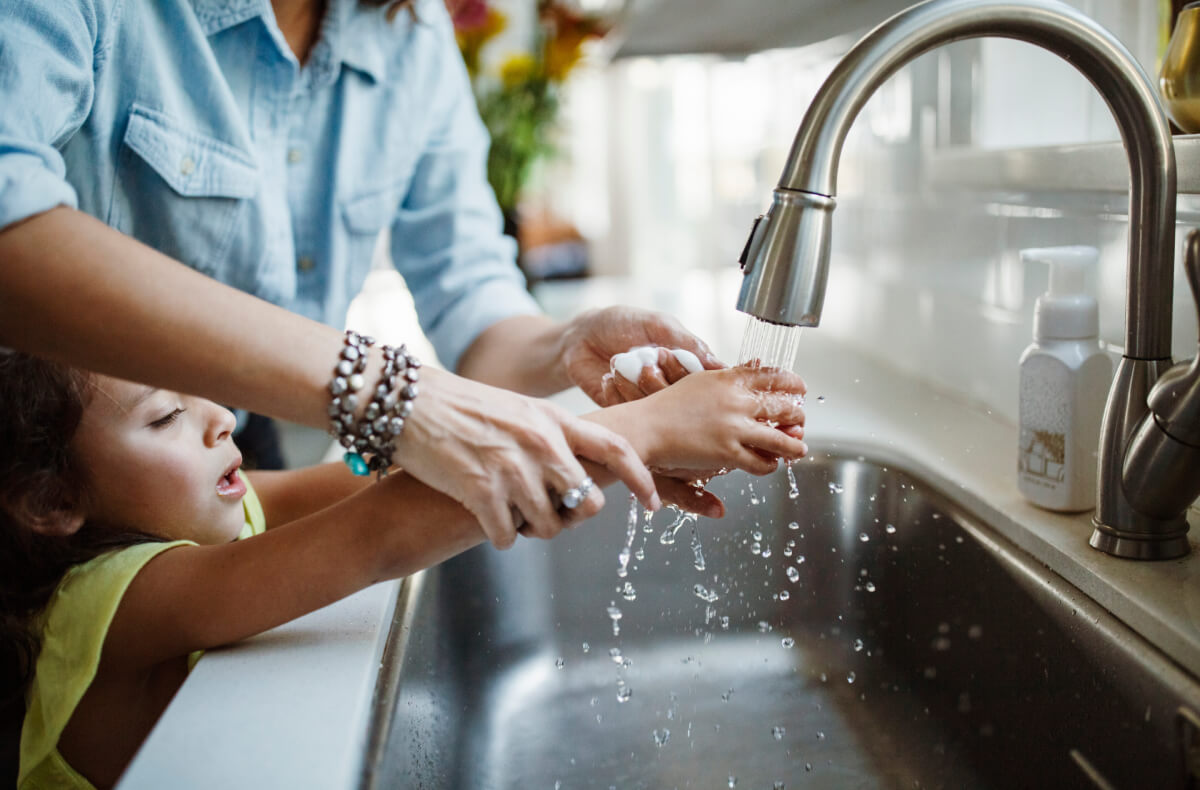Synopsis: Recover® system captures the Graywater instead of leaving the home or building, applies filtration and adds a small amount of chlorine for disinfection.
Application: Featuring Recover® Graywater Treatment System
Evie Trace (“E.T.”) Winslow had discovered that the activity levels on the jogging trails and bridle paths visible from her solarium were a reliable indicator of the emotional barometer of the community. Of late, significantly larger numbers had been jogging or cantering past. The natives of Trace were singularly restless. And E.T. knew why. The issue was water. Again.

Evie Trace (“E.T.”) Winslow glanced up from her computer as the sun streamed through the windows, warming the slate floor of the solarium. This had been her grandfather’s after-dinner cigar and brandy room, her mother’s music room, and now her own office. It was E.T.’s favorite place in the entire house. As always, she silently thanked her grandfather for positioning the room for excellent solar gain and the best view of the hills surrounding the expansive and exclusive community known as Trace.
It was certainly the perfect place to work on her well-respected blog, UpBuilding, a chronicle of advances in the building industry, covering the newest materials, evolving energy use guidelines and ratings, and the latest solutions to contemporary challenges. E.T.’s insightful, upbeat articles were frequently quoted in popular shelter magazines, giving the blog a significant mainstream following, too.
The blog had become her focus since, with a mix of relief and regret, she left a demanding and exhausting four globe-hopping decades as an environmental journalist and returned as heir to the house that was the origin and epicenter of Trace. Her 40-year credentials opened doors to industry insiders to fuel her well-read blog articles. Recognizing her influence, contacts always took her calls.
Home at Trace, E.T. was considered the keeper of the vision that had fueled her grandfather, Hatcher Trace, to develop the community that was his namesake. He built for those who shared his values: preservation of the environment, responsible home ownership, and—maybe most of all—seclusion and privacy. When property in Trace changed hands, as happened rarely, it was usually a legacy conveyance, as in E.T.’s case.
With many of the residents descending from the original owners, they shared a history and knowledge of each other’s families, professions, and peculiarities. But living their very disparate lives, they rarely encountered one another. This circumstance was as much physical as it was philosophical. Due to the rolling hills and series of road switchbacks, no residence was visible from any street. In fact, Trace was so secluded that it had acquired the nickname “No Trace” from folks living outside its enclave.
Of late, however, Trace residents had been paying much closer attention to each other, ever since the local water authority had announced an impending rate review. The communities that had sprung up around Trace claimed their share of water from local aquifers and other groundwater sources that, owing to changing climate patterns, had not replenished as readily as in years past.
Area water utilities were sometimes forced to rely on the water supply grid to meet demand, incurring additional charges, which ultimately landed on the water bills of the consumers. As an incentive to the communities to reduce water consumption, the utility announced they planned to implement a surcharge on any water usage that exceeded the most recent level. The surcharge would be enforced community wide, meaning that everyone’s water rate would bump up to the next higher billing level if overall usage increased, no matter who was responsible.
This announcement prompted a flurry of calls to E.T. to see if she had any ideas on how to counter the surcharge.
It would not be the first attempt at concerted water conservation efforts at Trace. This was part of the Trace DNA. Over the years, residents had dutifully switched to low-flow showerheads and toilets, upgraded to efficient appliances for laundry and dishwashing. As befit their Trace history, they did so voluntarily and willingly.
A Trace of Suspicion
This time, however, there was a growing resentment and reluctance to reduce water usage when doing so might cut into their quality of life as much as into their pocketbook, even if they could readily afford a higher water rate. With a certain amount of indignation, everyone felt they were already doing their individual part to use water responsibly. But they weren’t so sure about their neighbors.
So when they appealed to E.T. for ways control overall water use at Trace, they also shared their speculations.
Dade Parker said he was pretty sure that Nan Bowles’ extensive hobby of hydroponic gardening was using water greatly out of proportion to everyone else.
And Nan Bowles suggested that the Camaratas were at least partly responsible. “Those five teenagers are all on the amateur tennis circuit. Can you imagine keeping them in clean tennis whites? And think of the endless showers!”
The Camaratas pointed out that Mitch Oberlin’s small fleet of show-quality vintage cars were perhaps being hosed down a bit too frequently.
And Mitch mentioned to E.T. that Dade Parker’s immaculately groomed putting green surely required much more watering than Mitch’s own native plant xeriscaping.
And so it went until each Trace resident had casually and discreetly intimated that “Someone else is messing up this good thing we have at Trace.”
To de-escalate this growing frustration, E.T. suggested a meeting of all Trace neighbors, a focused brainstorming session with a simple goal: Find a way to cut the collective water use. She volunteered to host.
Wanted: One Simple Water-saving Miracle
E.T. sat at her computer desk and pondered the upcoming meeting. As she often did when she was deep in a problem, she gazed up at her grandfather’s stately portrait, as though seeking the wisdom that he so generously shared when he was alive. She would swear it prompted some of her best thinking. And there were times when the incoming sunlight streaming across the portrait made it seem as though he had just winked at her. The connection felt almost palpable.
As she focused on the portrait, she recalled her grandfather’s stories of Trace citizens responding to circumstances that threatened either the whole of Trace or any one of them, such as when a lightning strike ignited the woods around Trace. As professional firefighters fought the blaze, Trace neighbors formed their own brigade to hose down the houses nearest the fire’s edge, and relocated the stabled horses temporarily to individual properties farthest from the fire, with trailers at the ready to evacuate them.
She recollected his story of how the Camarata twins decided to arrive prematurely after a freak overnight snowstorm had paralyzed all movement in Trace. Trace horse owners hitched their pampered purebred hunters and jumpers to an antique sleigh and managed to transport Ann Camarata to an ambulance waiting on an open road five miles outside Trace.
E.T. knew that Trace was inherently better than its current snarky attitudes. She sighed, “Must be a product of the current times.”
She mused aloud, “Now what can galvanize these folks into common effort instead of pointing fingers?”
The mere thought of it made E.T. thirsty. She reached for her sports water bottle. As she unscrewed the blue top of the insulated silver cylinder, her eyes flew open wide. She smiled up at the portrait as she reached for her phone.
“Better Water, Better World. This is Aerobe. How may I help you?”
“Hi, Aerobe, this is E.T. Winslow. Do you have a moment?”
“Of course, E.T., so nice to hear from you! What’s going on and how can we help?”
E.T. had interviewed Aerobe recently for an UpBuilding post about Eco, Aerobe’s robotic dog whose unique talent was detecting underground water leaks and septic system fails. It had been one of the most popular blog articles of the year, the perfect blend of advanced science (robots!) and human interest (well, dogs!).

E.T. explained the current water challenges at Trace to Aerobe and how it was bringing the diverse residents of Trace together, although not necessarily in a good way.
“I just wish there were some smart new fix that would help cut everyone’s water usage, so they could all could go back to minding their own business. Do you have any new miracles like this at BioMicrobics®?”
“Actually, E.T., there is something that might be just the answer for Trace. Would you like me to share this technology at your meeting?” Aerobe asked.
E.T. replied, “As long as it doesn’t disturb Dade’s putting green or limit the tennis teens’ showers or threaten Nan’s tomatoes, I’ll be all ears.”
“I promise you, no digging required and no need to curtail water use for anyone’s lifestyle. It’s actually one of our simplest water solutions to date. And if you think the temperature of the meeting might be a bit frosty, perhaps I’ll bring Eco along. He’s proven to be quite an effective icebreaker,” Aerobe suggested.
Aerobe continued, “I’ll add your meeting to my schedule. But right now, tell me a little more about the residents of Trace…”







